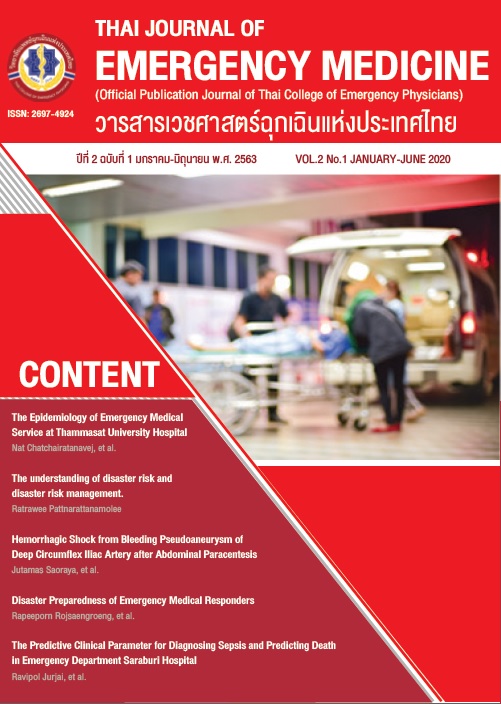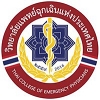The Predictive Clinical Parameter for Diagnosing Sepsis and Predicting Death in Emergency Department Saraburi Hospital
Keywords:
Sepsis, Vital signs, Screening, MortalityAbstract
Introduction : Sepsis is a crucial cause of death worldwide. Early diagnosis and treatment can reduce the mortality rate. The vital signs measurement may be used as a quick and convenient screening tool for an early diagnosis of sepsis.
Objectives : This study was aimed to evaluate the correlation between triage of clinical parameters including vital signs and other possible factors and diagnosis of sepsis-related and mortality.
Method : This exploratory retrospective cohort included patients visiting the Emergency Department at Saraburi hospital during January 2019. The patients were categorized into 2 subgroups: (1) diagnosed with sepsis and (2) diagnosed otherwise. These two subgroups will proceed for further analysis including the correlation between the incidence of sepsis and baseline characteristics, triage vital signs, underlying diseases, and confounding factors with the diagnosis of sepsis and sepsis-related mortality.
Results : This study enrolled a total of 500 patients, who were classified into sepsis (n = 82) and non-sepsis (n = 418) groups. The study found that the age [Adjust risk ratio (aRR): 1.02, 95% CI: 1.01-1.04], heart rate [aRR: 1.01, 95% CI: 1.01-1.02], body temperature [aRR: 1.35, 95% CI: 1.12-1.63], oxygen saturation [aRR: 0.96, 95% CI: 0.93-0.99], immunocompromised host [aRR: 4.79, 95% CI: 1.80-12.77] and cerebrovascular disease [aRR: 1.82, 95% CI: 1.01- 3.27] were significantly correlated to sepsis risk, whereas hypertension [aRR: 0.55, 95% CI: 0.31-0.97] showed significant reverse correlation. However, only respiratory rate has shown significant correlation with the mortality rate in the sepsis subgroup. [aRR: 1.06, 95% CI: 1.01-1.13]
Conclusion : Age, heart rate, body temperature, oxygen saturation, immunocompromised host and cerebrovascular disease are strong predictors for the diagnosis of sepsis and respiratory rate is the only parameter that associated with sepsis-related mortality rate among those diagnosed with sepsis.
References
Seymour CW, Liu VX, Iwashyna TJ, Brunkhorst FM, Rea TD, Scherag A, et al. Assessment of Clinical Criteria for Sepsis: For the Third International Consensus Definitions for Sepsis and Septic Shock (Sepsis-3). JAMA. 2016 Feb 23;315(8):762–74.
Fleischmann C, Scherag A, Adhikari NKJ, Hartog CS, Tsaganos T, Schlattmann P, et al. Assessment of Global Incidence and Mortality of Hospital-treated Sepsis. Current Estimates and Limitations. Am J Respir Crit Care Med. 2016 Feb;193(3):259–72.
The Inspection division of The Thailand ministry of public health. Service plan of health outcome of KPI 3: Achieved goal of Mortality in community- acquired severe sepsis. Annual inspection report 2014 in The Ministry of public health. 2014. p. 448–59.
The Thailand ministry of public health. Health Data Center in The Thailand ministry of public health [Internet]. 2015. [cited 2020 Dec 30]. Available from: https://hdcservice.moph.go.th/hdc/main/index_pk.php
Vincent J-L. The Clinical Challenge of Sepsis Identification and Monitoring. PLoS Med. 2016 May 17;13(5):1–10.
Singer M, Deutschman CS, Seymour CW, Shankar-Hari M, Annane D, Bauer M, et al. The Third International Consensus Definitions for Sepsis and Septic Shock (Sepsis-3). JAMA.2016 Feb 23;315(8):801–10.
Levy MM, Evans LE, Rhodes A. The Surviving Sepsis Campaign Bundle: 2018 Update. Critical Care Medicine. 2018 Jun;46(6):997–1000.
Churpek MM, Snyder A, Han X, Sokol S, Pettit N, Howell MD, et al. Quick Sepsis-related Organ Failure Assessment, Systemic Inflammatory Response Syndrome, and Early Warning Scores for Detecting Clinical Deterioration in Infected Patients outside the Intensive Care Unit. Am J Respir Crit Care Med. 2017 Apr;195(7):906–11.
Armstrong BP, Clancy M, Simpson H. Making sense of vital signs. Emergency Medicine Journal. 2008 Dec 1;25(12):790–1.
Gilbert BW, Faires L, Meister A, Huffman J, Faber RK. Comparison of Sepsis-3 Criteria Versus SIRS Criteria in Screening Patients for Sepsis in the Emergency Department. Advanced Emergency Nursing Journal. 2018;40(2):138–43.
Rodriguez RM, Greenwood JC, Nuckton TJ, Darger B, Shofer FS, Troeger D, et al. Comparison of qSOFA with current emergency department tools for screening of patients with sepsis for critical illness. Emerg Med J. 2018 Jun;35(6):350–6.
Tirotta D, Gambacorta M, La Regina M, Attardo T, Lo Gullo A, Panzone F, et al. Evaluation of the threshold value for the modified early warning score (MEWS) in medical septic patients: a secondary analysis of an Italian multicentric prospective cohort (SNOOPII study). QJM. 2017 Jan;110(6):369–73.
RCP London. National Early Warning Score (NEWS) 2 [Internet]. 2019 [cited 2020 Dec 30]. Available from: https://www.rcplondon.ac.uk/projects/outputs/national-earlywarning-score-news-2
Roberts JR, Custalow CB, Thomsen TW. Roberts and Hedges’ clinical procedures in emergency medicine and acute care [Internet]. 2019 [cited 2020 Dec 30]. Available from: http://ezproxy.usherbrooke.ca/login?url=https://www.clinicalkey.com/#!/browse/book/3-s2.0-C20140019958
WHO.int. Pulse Oximetry Training Manual [Internet]. 2019 [cited 2020 Dec 30]. Available from: https://www.who.int/patientsafety/safesurgery/pulse_oximetry/who_ps_pulse_oxymetry_training_manual_en.pdf
Chow S-C, Wang H, Shao J. Sample Size Calculations in Clinical Research. Secondedition. New York: Chapman and Hall/CRC;2007. 480 p.
De La Rica AS, Gilsanz F, Maseda E. Epidemiologic trends of sepsis in western countries. Annals of Translational Medicine. 2016 Sep;4(17):325–325.
Sanfilippo F, Corredor C, Fletcher N, Landesberg G, Benedetto U, Foex P, et al. Diastolic dysfunction and mortality in septic patients: a systematic review and meta-analysis. Intensive Care Med. 2015 Jun;41(6):1004–13.
Takayama K, Yuhki K, Ono K, Fujino T, Hara A, Yamada T, et al. Thromboxane A2 and prostaglandin F2α mediate inflammatory tachycardia. Nat Med. 2005 May;11(5):562–6.
Lelubre C, Vincent J-L. Mechanisms and treatment of organ failure in sepsis. Nat Rev Nephrol. 2018 Jul;14(7):417–27.
Rumbus Z, Matics R, Hegyi P, Zsiboras C, Szabo I, Illes A, et al. Fever Is Associated with Reduced, Hypothermia with Increased Mortality in Septic Patients: A Meta-Analysis of Clinical Trials. Lazzeri C, editor. PLoS ONE. 2017 Jan 12;12(1):1–15.
Kushimoto S, Yamanouchi S, Endo T, Sato T, Nomura R, Fujita M, et al. Body temperature abnormalities in non-neurological critically ill patients: a review of the literature. j intensive care. 2014 Dec;2(1):1–16.
Gofton TE, Young GB. Sepsis-associated encephalopathy. Nat Rev Neurol. 2012 Oct;8(10):557–66.
Esper AM, Moss M, Lewis CA, Nisbet R, Mannino DM, Martin GS. The role of infection and comorbidity: Factors that influence disparities in sepsis: Critical Care Medicine. 2006 Oct;34(10):2576–82.
Zaid Y, Rajeh A, Hosseini Teshnizi S, Alqarn A, Tarkesh F, Esmaeilinezhad Z, et al. Epidemiologic features and risk factors of sepsis in ischemic stroke patients admitted to intensive care: A prospective cohort study. Journal of Clinical Neuroscience. 2019 Nov;69:245–9.
Brun-Buisson C. Incidence, Risk Factors, and Outcome of Severe Sepsis and Septic Shock in Adults: A Multicenter Prospective Study in Intensive Care Units. JAMA. 1995 Sep 27;274(12):968–74.
Nunes JP. Arterial hypertension and sepsis. Rev Port Cardiol. 2003 Nov;22(11):1375–9.
Mohamed AS, Mehta A, James P. Predictors of mortality of severe sepsis among adult patients in the medical Intensive Care Unit. Lung India. 2017;34(4):330–5.
Weng L, Zeng X-Y, Yin P, Wang L-J, Wang C-Y, Jiang W, et al. Sepsis-related mortality in China: a descriptive analysis. Intensive Care Med. 2018 Jul;44(7):1071–80.
Frydrych LM, Bian G, O’Lone DE, Ward PA, Delano MJ. Obesity and type 2 diabetes mellitus drive immune dysfunction, infection development, and sepsis mortality. J Leukoc Biol. 2018 Sep;104(3):525–34.
Mansur A, Mulwande E, Steinau M, BergmannI, Popov AF, Ghadimi M, et al. Chronic kidney disease is associated with a higher 90-day mortality than other chronic medical conditions in patients with sepsis. Sci Rep. 2015 May 21;5:1–8.
Rudd KE, Johnson SC, Agesa KM, Shackelford KA, Tsoi D, Kievlan DR, et al. Global, regional, and national sepsis incidence and mortality, 1990–2017: analysis for the Global Burden of Disease Study. The Lancet. 2020 Jan;395(10219):200–11.

Downloads
Published
How to Cite
Issue
Section
Categories
License
บทความที่ได้รับตีพิมพ์ในวารสารเวชศาสตร์ฉุกเฉินแห่งประเทศไทย ถือเป็นเป็นลิขสิทธิ์ของ วิทยาลัยแพทย์เวชศาสตร์ฉุกเฉินแห่งประเทศไทย
กรณีที่บทความได้รับการตีพิมพ์ในวารสารเวชศาสตร์ฉุกเฉินแห่งประเทศไทยแล้ว จะตีพิมพ์ในรูปแบบอิเล็กทรอนิกส์ ไม่มีสำเนาการพิมพ์ภายหลังหนังสือเผยแพร่เรียบร้อยแล้ว ผู้นิพนธ์ไม่สามารถนำบทความดังกล่าวไปนำเสนอหรือตีพิมพ์ในรูปแบบใดๆ ที่อื่นได้ หากมิได้รับคำอนุญาตจากวารสารเวชศาสตร์ฉุกเฉินแห่งประเทศไทย



